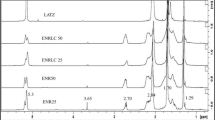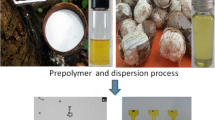Abstract
Vegetable oil with the advantages of biodegradability and low cost has been used as a plasticizer in the rubber industry. This study investigates the conditions of vegetable oil nanoemulsion as a plasticizer in natural rubber (NR) latex. Vegetable oil nanoemulsion with the particle size of 10.4 nm is prepared from blending coconut kernel oil/soybean oil, Tween 80 and water using phase inversion temperature method. The vegetable oil nanoemulsion is then added to NR latex. During the initial three days, latex particles have swollen, but subsequently they shrunk from 2673 to 1511 nm due to phase inversion. The result indicates that the tensile strength of latex films could be improved significantly with both higher incubation and vulcanization temperatures at 50 °C and 120 °C, respectively. Contact angle on the film surface is less than 90°, showing that there is no oil blooming onto the surface.








Similar content being viewed by others
References
Parker SP (ed) (2003) McGraw-Hill dictionary of scientific and technical terms. McGraw-Hill Education, New York
Whelan A (2012) Polymer technology dictionary. Springer, Berlin
Chin PS, O’Connell J (1969) Oil extension of natural rubber at latex stage. J Rubb Res Inst Malaya 22:91–103
Kondo H (2016) Oil-extended natural rubber and method for producing the same and rubber composition and tire using the same. US Patent 9,487,047B2, 8 Nov 2016
Sakaki T, Ichikawa N, Hattori T, Ho CC, Choong DH (2011) Preparation process of oil extended rubber for tire, oil extended rubber for tire, and rubber composition and tire using the same. US Patent 8,044,118B2, 25 Oct 2011
Wendling P, Peter R, Koski AA (2001) Process for preparation of rubber silica masterbatches based on the use of polymer lattices. CA 2381514A1, 15 Feb 2001
Song GJ et al (2009) Preparation of oil-extended montmorillonite-extended latex coprecipitation rubber. CN Patent 101475714A, 8 Jul 2009
Ichikawa N, Nobuchika H (2005) Compounded deproteinized natural rubber latex and dipped rubber product using the same. JP Patent 2005120153A, 12 May 2005
Nandanan V (2000) Studies on the use of drying oils as ingredients in the vulcanization of elastomer. Dissertation, Cochin University of Science and Technology
Ciesielski A (2001) An introduction to rubber technology. iSmithers Rapra Publishing, Shrewsbury
Jayewardhana WGD, Perera GM, Edirisinghe DG, Karunanayake L (2009) Study on natural oils as alternative processing aids and activators in carbon black filled natural rubber. J Natl Sci Found Sri Lanka 37:187–193
Li J, Isayev AI, Ren X, Soucek MD (2015) Modified soybean oil-extended SBR compounds and vulcanizates filled with carbon black. Polymer 60:144–156
Heng YX, Lee SY, Cheong KW, Heng YK, Ling YTQ, Tan ST (2018) Effect of emulsion particle size on the natural rubber latex film properties in the presence of renewable lipid emulsions. In: Dzaraini K et al. (eds) National symposium on polymeric materials 2017, Selangor, October 2017. AIP conference proceedings, vol 1985. AIP Publishing, Melville, p 040002
Ling YTQ, Lee SY, Cheong KW, Tay SL, Tan ST, Heng YX (2018) Swelling of natural rubber latexes in vegetable oil emulsion: particle size measurement. In: Dzaraini K et al. (eds) National symposium on polymeric materials 2017, Selangor, October 2017. AIP Conference Proceedings, vol 1985. AIP Publishing, Melville, p 040003
Lee SY, Fauzi MS, Amir HMY, Heng YX, Ling YTQ (2018) A novel vegetable oil nanoemulsion-plasticized natural rubber latex compound: effect of ingredient blending sequence on crosslink density and tensile strengths. In: Dzaraini K et al. (eds) National symposium on polymeric materials 2017, Selangor, October 2017. AIP conference proceedings, vol 1985. AIP Publishing, Melville, p 040013
Lee SY, Ng A, Singh MSJ, Liew YK, Gan SN, Koh RY (2017) Physicochemical and antimicrobial properties of natural rubber latex films in the presence of vegetable oil microemulsions. J Appl Polym Sci 134:44788
Lee SY, Tan ST, Cheong KW, Kuok KM, Heng YX, Ling YTQ (2018) Development of biocompatible natural rubber latex film incorporated with vegetable oil microemulsion as plasticizer: Effect of curing conditions. In: Dzaraini K et al. (eds) National symposium on polymeric materials 2017, Selangor, October 2017. AIP conference proceedings, vol 1985. AIP Publishing, Melville, p 040004
Chaikumpollert O, Yamamoto Y, Suchiva K, Kawahara K (2012) Mechanical properties and cross-linking structure of cross-linked natural rubber. Polym J 44:772–777
Valentin JL, Carretero-Gonzalez J, Mora-Barrantes I, Chasse W, Saalwachter K (2008) Uncertainties in determination of cross-link density by equilibrium swelling experiments in natural rubber. Macromolecules 41:4717–4729
Orwoll RA (2007) Densities, coefficients of thermal expansion, and compressibilities of amorphous polymers. In: Mark JE (ed) Physical properties of polymer handbook, vol 2. Springer, New York, pp 93–102
Tanford C (1973) The hydrophobic effect: formation of micelles and biology. Wiley, New York
Israelachivili JN, Mitchell DJ, Ninham BW (1976) Theory of self-assembly of hydrocarbon amphiphiles into micelles and bilayers. J Chem Soc, Faraday Trans 2(72):1525–1568
Nagarajan R, Ruckenstein E (1991) Theory of surfactant self-assembly: a predictive molecular thermodynamic approach. Langmuir 7:2934–2969
Nagarajan R (2003) Theory of micelle formation: Quantitative approach to predicting the micellar properties from surfactant molecular structure. In: Esumi K, Ueno M (eds) Structure-performance relationships in surfactants. Marcel Dekker, New York, pp 1–89
Nagarajan R, Ruckenstein E (2000) Self-assembled systems. In: Sengers JV, Kayser RF, Peters CJ, White HJ (eds) Equations of state for fluids and fluid mixtures, vol 5. Elsevier Science, Amsterdam, pp 589–749
Nagarajan R (2002) Molecular packing parameter and surfactant self-assembly: neglected role of the surfactant tail. Langmuir 18:31–38
Yu L, Li C, Xu J, Hao J, Sun D (2012) Highly stable concentrated nanoemulsions by the phase inversion composition method at elevated temperature. Langmuir 28:14547–14552
Silverajah VS, Ibrahim NA, Yunus WMZW, Hassan HA, Chieng BW (2012) A comparative study on the mechanical, thermal and morphological characterization of poly(lactic acid)/epoxidized palm oil blend. Int J Mol Sci 13:5878–5898
Norhazariah S, Azura AR, Sivakumar R, Azahari B (2016) Effect of different preparation methods on crosslink density and mechanical properties of carrageenan filled natural rubber (NR) latex films. Procedia Chem 19:986–992
Ho CC, Khew MC (2000) Surface free energy analysis of natural and modified natural rubber latex films by contact angle method. Langmuir 16:1407–1414
Acknowledgements
The authors would like to extend heartfelt appreciation and gratitude to Dr. Manroshan Singh Jaswan Singh from Malaysian Rubber Board for providing technical advice.
Funding
This work was supported by Malaysian Rubber Board (Grant number: S17STL0663).
Author information
Authors and Affiliations
Corresponding author
Ethics declarations
Conflict of interest
The authors declare that they have no conflict of interest.
Additional information
Publisher's Note
Springer Nature remains neutral with regard to jurisdictional claims in published maps and institutional affiliations.
Rights and permissions
About this article
Cite this article
Heng, Y.X., Ling, Y.T.Q., Lee, S.Y. et al. Natural rubber latex film in the presence of renewable vegetable oil nanoemulsion. Polym. Bull. 78, 2103–2120 (2021). https://doi.org/10.1007/s00289-020-03201-8
Received:
Revised:
Accepted:
Published:
Issue Date:
DOI: https://doi.org/10.1007/s00289-020-03201-8




